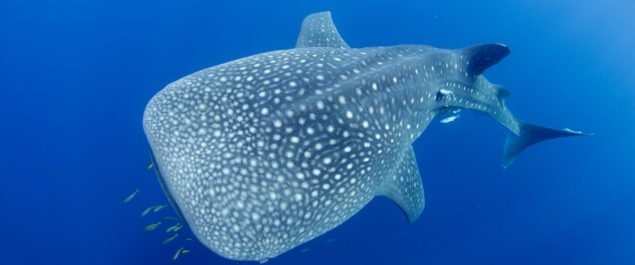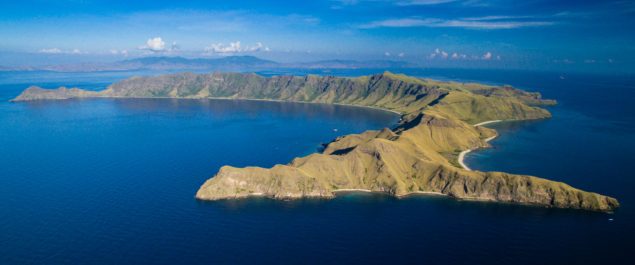Manta Point Bali Dive Site Spotlight
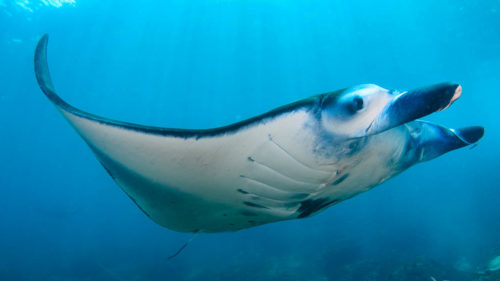
Manta Point Bali is the latest in our ongoing series of dive site spotlights. This site is obviously one of the most popular and famous in Bali. Although it’s located in Nusa Penida, it’s a site that is done on many day trips from the mainland. As the name may suggest, the main attraction of this dive site is Manta Rays! Every diver or snorkeler loves to encounter these giants of the deep. Thankfully, Bali is home to one of the best places on the planet to see them. Although this site can be quite busy, the mantas are almost always there.
Where is Manta Point?
Manta Point is located on the SE coast of the island of Nusa Penida, less than 20 NM from Sanur. Boats leaving from the mainland typically take 45 minutes to 1 hour to reach it. Boats departing from Penida or Lembongan reach the site in around half that time. The site itself faces to the south east and can be exposed to waves when there is swell from the Indian Ocean. Therefore, sometimes it’s not possible to dive this site if the weather is rough.
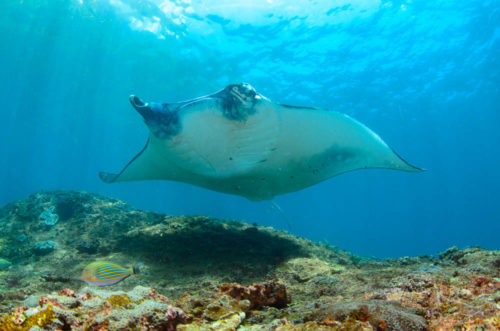
What to Expect at Manta Point Bali?
Manta Point is truly a unique experience. When dropping toward the bottom, the first thing a diver notices is the lack of large coral formations that are found throughout Indonesia. Due to the wave action that often sweeps the coast, the environment is more of a rocky structure with a few low lying corals. Doing the dive itself is different than many other dives. There are two ways to do the dive, drop onto the deep cleaning station and work shallow. Or the second option, which is to start at the shallow cleaning station and either stay there or work toward the deeper one. Of course, these options are mostly based on where the mantas are!
The manta rays here are visiting in order to be cleaned of parasites. Therefore, it’s very important to not get in the way of the manta rays and allow them to act naturally. In the shallows there are a series of large rocks, the largest of which is a cleaning station. What is a cleaning station? This is an area where small fish who eat parasites off of other fish congregate. The mantas come here to allow the fish to pick parasites off their body. It’s not uncommon to see more than 10 mantas on a dive here. The rays will take turns while waiting for the cleaning service. One or two mantas will circle slowly at the top of the rock before peeling off and allowing the next one in line to have a turn.
When is the Best Time to Go?
The shallow cleaning station can be a very crowded place, both with rays and with divers! We try to either be one of the first boats on location or one of the last. During peak season, it can be difficult to have a good manta encounter due to the sheer amount of divers in the water. Surprisingly, this has not scared away the rays. We keep a close eye on conditions and tides to try to get there at the best time to avoid the crowds. The manta rays are present here throughout the year.
From June to November water temperatures can be as low as 18C (65F). From December to May, the water warms up and is typically in the mid to high 20s C or high to low 80s F. December to May is the rainy season so there is the possibility of more nutrients in the water during that time. However, Manta Point is not known as a site with great visibility at the best of times. However, that doesn’t matter because…. Mantas!
Will I See Anything Other Than Mantas?
Besides the big boys and girls, there are other inhabitants on the site such as schooling snappers, seasnakes, and blue spotted rays. At certain times of the year, blue spotted rays congregate in large groups. During the colder season, June to October, molas (sunfish) are also occassionally spotted here.
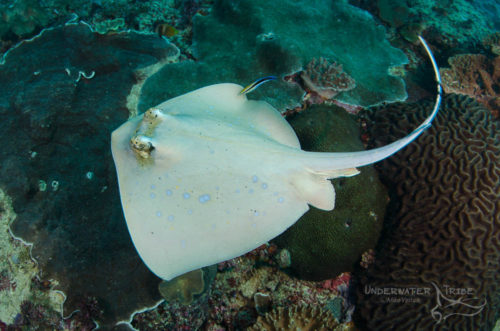
Best Practices at Manta Point Bali
Diving with manta rays is a very special event and demands certain practices. These gentle giants of the ocean are sensitive to their surroundings and divers must follow a few basic rules in order not to scare them away. The first rule is of course not to touch the animals. Many people always feel the need to touch animals in nature, please don’t do this! The second rule is not to chase the rays. When rays approach simply get low and stay where you are, quite often they will circle back. The third rule is to stay off of the cleaning station. This is where the cleaning fish live and why the mantas are here. If divers swim on top of the cleaning station then the cleaning fish and mantas will disappear. Photographers are often guilty of trying to get too close, please be aware of your surroundings.
Learn More
There are two species of mantas found in Indonesia, Pelagic and Reef. Reef mantas are the ones that we encounter at Manta Point. If you would like to learn more about these graceful animals visit Manta Trust. On this site you can also upload your pictures of manta rays to help in identifying their distribution.
Interested in more of our Bali Dive Site Spotlights? Check out Batu Niti or Melasti.
